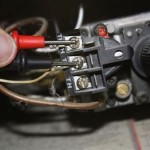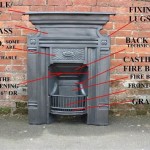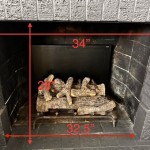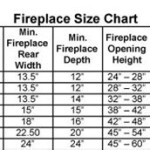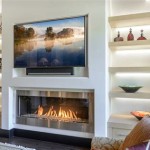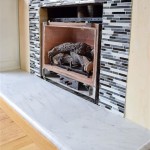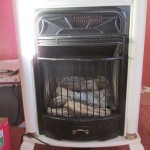Vintage Metal Fireplace Screens: A Timeless Blend of Function and Design
Vintage metal fireplace screens represent more than just a protective barrier; they are tangible links to bygone eras, embodying the design aesthetics and craftsmanship of previous generations. These screens, often crafted from materials like wrought iron, cast iron, or brass, served a crucial purpose in containing sparks and embers while simultaneously adding a touch of elegance and sophistication to the hearth. Their enduring appeal lies in their ability to seamlessly blend functionality with artistry, making them highly sought-after additions to both traditional and contemporary interiors.
The resurgence in popularity of vintage decor has fueled a renewed interest in these screens. Collectors and homeowners alike appreciate the unique character and historical significance that each piece possesses. Unlike mass-produced modern alternatives, vintage metal fireplace screens often feature intricate details, hand-forged elements, and distinctive patinas acquired over decades of use. This inherent uniqueness makes each screen a conversation starter and a focal point in any room.
Understanding the characteristics, historical context, and maintenance requirements of vintage metal fireplace screens is essential for anyone considering acquiring or preserving one. This article aims to provide a comprehensive overview of these timeless pieces, exploring their different styles, materials, common issues, and best practices for care and restoration.
Exploring the Diverse Styles and Designs
Vintage metal fireplace screens encompass a wide variety of styles, each reflecting the prevailing design trends of its era. Recognizing these styles is crucial for identifying the age and origin of a particular screen, as well as ensuring it complements the overall aesthetic of the room.
One common style is the Victorian screen, characterized by its ornate details, elaborate scrollwork, and often the inclusion of decorative elements such as floral motifs or mythical creatures. These screens were typically crafted from cast iron or wrought iron and were intended to exude opulence and grandeur within the Victorian parlor.
Art Nouveau screens, popular from the late 19th century to the early 20th century, are distinguished by their flowing, organic lines, asymmetrical designs, and the use of stylized natural forms. These screens often feature handcrafted elements, showcasing the artistry of the blacksmith or metalworker. Common motifs include irises, dragonflies, and other depictions of the natural world.
The Art Deco period, spanning the 1920s and 1930s, brought a more streamlined and geometric aesthetic to fireplace screen design. Art Deco screens often feature clean lines, symmetrical patterns, and the use of materials such as polished steel or chrome accents. These screens reflect the era's fascination with modernity and technology.
Moving into the mid-century modern era, fireplace screen designs became simpler and more functional. These screens often feature minimalist designs, clean lines, and the use of materials such as wrought iron and brass. The focus was on creating a practical and aesthetically pleasing piece that seamlessly integrated into the modern home.
Beyond these broad stylistic categories, there are numerous variations and sub-styles, each with its own unique characteristics. Some screens may feature a combination of design elements from different periods, reflecting the eclectic tastes of their original owners or the evolving design trends of the time.
Materials and Craftsmanship: A Look into the Past
The value and longevity of a vintage metal fireplace screen are directly linked to the materials used in its construction and the quality of its craftsmanship. Understanding the properties of different metals and the techniques employed in their fabrication is essential for appreciating the artistry and durability of these pieces.
Wrought iron was a common material for fireplace screens, particularly in earlier periods. It is known for its strength, malleability, and resistance to corrosion. Wrought iron screens were often hand-forged by skilled blacksmiths, resulting in unique, one-of-a-kind pieces. The distinctive texture and subtle imperfections of hand-forged wrought iron contribute to the charm and character of these screens.
Cast iron, another popular material, is formed by pouring molten iron into a mold. This process allows for the creation of intricate designs and detailed patterns. Cast iron screens are typically heavier and more durable than wrought iron screens, but they are also more prone to cracking or breaking if subjected to sudden impacts.
Brass, with its warm, golden hue, was often used for decorative accents or entire fireplace screens. Brass screens were frequently polished to a high shine, adding a touch of elegance and sophistication to the hearth. While brass is relatively resistant to corrosion, it can tarnish over time, requiring periodic cleaning and polishing to maintain its luster.
The craftsmanship of vintage metal fireplace screens varied depending on the era and the skill of the artisan. Hand-forged screens, in particular, represent a significant investment of time and labor. Blacksmiths would painstakingly shape and weld the metal, creating intricate designs and ensuring the structural integrity of the piece. Machine-made screens, while often less expensive, still required skilled labor to assemble and finish.
Identifying the materials and craftsmanship of a vintage metal fireplace screen can provide valuable insights into its age, origin, and value. Examining the construction techniques, the presence of maker's marks, and the overall quality of the finish can help determine whether a screen is a genuine antique or a later reproduction.
Care, Restoration, and Preservation to Maintain Vintage Aesthetic
Preserving a vintage metal fireplace screen requires careful attention to cleaning, maintenance, and, in some cases, restoration. Proper care can help prevent further deterioration and ensure that the screen continues to enhance the beauty of the hearth for years to come.
Regular cleaning is essential for removing dust, soot, and other debris that can accumulate on the screen's surface. A soft brush or cloth can be used to gently wipe down the screen, paying particular attention to intricate details and crevices. For more stubborn dirt or grime, a mild soap-and-water solution can be used, followed by thorough rinsing and drying.
Rust is a common problem for vintage metal fireplace screens, especially those made from iron. To prevent rust, it is important to keep the screen dry and to apply a protective coating of wax or oil. If rust has already formed, it can be removed using a wire brush or sandpaper, followed by the application of a rust-inhibiting primer and paint.
Damaged or broken screens may require professional restoration. A skilled metalworker can repair cracks, re-weld broken joints, and replace missing components. When restoring a vintage metal fireplace screen, it is important to use materials and techniques that are consistent with the original construction. Avoid using harsh chemicals or abrasive cleaners that could damage the screen's finish or alter its patina.
The patina, or surface discoloration, of a vintage metal fireplace screen is often considered a desirable characteristic, reflecting the screen's age and history. While some collectors prefer to preserve the original patina, others may choose to clean and polish the screen to restore its original luster. The decision to preserve or alter the patina is a matter of personal preference, but it is important to consider the potential impact on the screen's value and authenticity.
Proper storage is also crucial for preserving vintage metal fireplace screens. When not in use, the screen should be stored in a dry, well-ventilated area, away from direct sunlight and extreme temperatures. Wrapping the screen in a protective cloth or plastic sheet can help prevent dust and moisture from accumulating. It is also important to handle the screen with care, avoiding any actions that could cause damage or breakage.
In conclusion, vintage metal fireplace screens offer a unique blend of functionality, artistry, and historical significance. By understanding their diverse styles, materials, and maintenance requirements, collectors and homeowners can appreciate the enduring beauty and value of these timeless pieces.

Old World Fireplace Screen Iron Accents

Old World Fireplace Screen Iron Accents

Vintage Fireplace Screens At Rs 13000 Piece In Delhi Id 18364794491

Wrought Iron Fireplace Screens Functionality And Style Accents

Vintage Brass Peacock Fireplace Screen Cover Cameo Folding Fan Victorian Antique Metal Fire

Black Metal Ornate Fire Screen Windsor Browne

Rl Sr Fl 13 Wrought Iron Fireplace Screen Modern Tools

Metal Fireplace Screen 3 Panel Wrought Iron Folding Vintage Mesh Cover 55 X 33

Rustic Antique Fireplace Screen P0913 Charles Nijman Antiques

Vintage Antique Brass And Stained Glass Fireplace Screen
Related Posts

